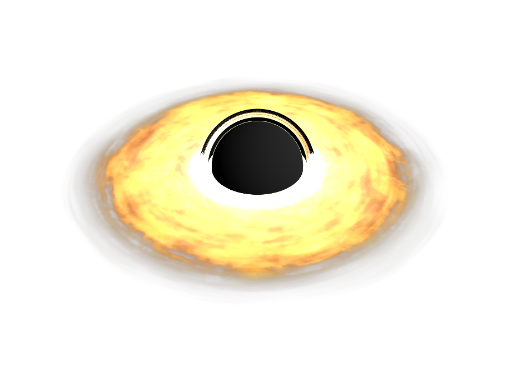Download top and best high-quality free Black Hole PNG Transparent Images backgrounds available in various sizes. To view the full PNG size resolution click on any of the below image thumbnail.
License Info: Creative Commons 4.0 BY-NC
Black holes are one of the most fascinating and mysterious objects in the universe. They are areas in space where gravity is so strong that nothing, not even light, can escape its pull. They are invisible, yet have the power to distort space and time, and can swallow even the biggest stars and galaxies.
What is a black hole?
Black holes are formed when a massive star runs out of fuel and collapses under its own gravity. This collapse creates an infinitely dense object called a singularity, surrounded by a region called the event horizon. The event horizon is the point of no return, where the gravitational pull is so strong that anything crossing it will be trapped inside forever.
The size of the event horizon is directly related to the mass of the black hole. The more massive the black hole, the larger the event horizon. The smallest black holes are just a few kilometers wide, while the largest can be billions of times the mass of the sun, with event horizons that span millions of kilometers.
How do we detect black holes?
Black holes cannot be seen directly, as they do not emit any light or radiation. However, their presence can be inferred from their effects on surrounding matter. When a black hole is near a star or gas cloud, the immense gravitational pull strips the material away, creating an accretion disk of hot gas that emits X-rays and other forms of radiation. These emissions can be detected by telescopes and satellites, allowing scientists to study the properties of black holes and their surroundings.
Another method of detecting black holes is through gravitational waves. When massive objects, like black holes, merge, they create ripples in the fabric of space and time, which can be detected by sensitive instruments on Earth, like the Laser Interferometer Gravitational-Wave Observatory (LIGO).
What happens if you fall into a black hole?
Falling into a black hole is a one-way trip to oblivion. As you get closer to the event horizon, the gravitational pull becomes stronger, and time itself slows down. If you were to watch someone falling into a black hole from a safe distance, they would appear to slow down and become redder and dimmer as their light is stretched by the intense gravity.
As they cross the event horizon, their fate is sealed. The gravitational tidal forces become so intense that they stretch and tear apart everything, including atoms, molecules, and even subatomic particles. This process is called spaghettification, and the unlucky traveler is reduced to a stream of atoms that swirl around the singularity.
What is the Hawking radiation?
Black holes are not entirely black. According to the theory proposed by physicist Stephen Hawking, black holes emit a faint glow of particles called Hawking radiation. This radiation is generated by the quantum fluctuations near the event horizon, which allows pairs of particles to be created, one of which falls into the black hole, while the other escapes into space.
Over time, this process causes black holes to slowly evaporate, losing mass and energy in the form of radiation. The smallest black holes, which have a mass less than the moon, are expected to evaporate completely in a fraction of a second, while larger ones can last for trillions of years.
Why are black holes important?
Black holes play a crucial role in the evolution of galaxies. They are responsible for powering some of the brightest and most energetic phenomena in the universe, such as quasars, gamma-ray bursts, and active galactic nuclei. They also shape the structure of galaxies, by influencing the motion and distribution of stars and gas.
Black holes also challenge our understanding of the laws of physics. They are the ultimate test of our theories of gravity, quantum mechanics, and the nature of space and time. Studying black holes can help us unlock some of the deepest mysteries of the universe and advance our knowledge of the fundamental laws of nature.
Black holes are mysterious and fascinating objects that capture the imagination of scientists and the general public alike. They are invisible, yet their presence can be inferred from their effects on surrounding matter. They are terrifying, yet they hold the key to some of the deepest mysteries of the universe. They are a reminder of the vastness and complexity of the cosmos, and the infinite possibilities that lie within it.
Download Black Hole PNG images transparent gallery
- Black Hole PNG Pic
Resolution: 894 × 894
Size: 1126 KB
Image Format: .png
Download
- Black Hole PNG Picture
Resolution: 512 × 512
Size: 8 KB
Image Format: .png
Download
- Black Hole PNG
Resolution: 512 × 384
Size: 116 KB
Image Format: .png
Download
- Black Hole Transparent
Resolution: 499 × 481
Size: 433 KB
Image Format: .png
Download
- Black Hole
Resolution: 512 × 512
Size: 38 KB
Image Format: .png
Download
- Black Hole PNG Clipart
Resolution: 446 × 480
Size: 137 KB
Image Format: .png
Download
- Black Hole PNG Cutout
Resolution: 628 × 481
Size: 222 KB
Image Format: .png
Download
- Black Hole PNG File
Resolution: 1230 × 1264
Size: 2216 KB
Image Format: .png
Download
- Black Hole PNG HD Image
Resolution: 200 × 200
Size: 6 KB
Image Format: .png
Download
- Black Hole PNG Image HD
Resolution: 493 × 501
Size: 247 KB
Image Format: .png
Download
- Black Hole PNG Image
Resolution: 502 × 448
Size: 317 KB
Image Format: .png
Download
- Black Hole PNG Images
Resolution: 625 × 625
Size: 94 KB
Image Format: .png
Download
- Black Hole PNG Photo
Resolution: 256 × 256
Size: 32 KB
Image Format: .png
Download
- Black Hole PNG Photos
Resolution: 512 × 512
Size: 263 KB
Image Format: .png
Download













